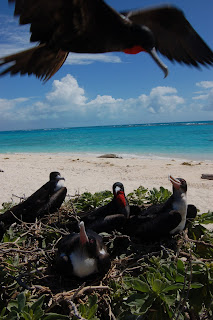
Journey with me to sun-kissed, wind-spanked Tern Island of the French Frigate Shoals, where humans play second fiddle to the abundant wildlife. My time on Tern will last from late January to early April. I will be tagging Laysan and Black-footed albatross with GPS, satellite and archival tags to track their movements over the north Pacific as part of my post-graduate research project. I hope this blog provides a little window into the lives of seabirds and the people who study them.
Saturday, February 23, 2008
PRIUS

Meet Prius, the hybrid albatross! This unique bird is the product of a union between a Laysan albatross and a black-footed albatross, both of which breed sympatrically on Tern Island. The behavior of the two species is quite different, which makes Prius a very interesting individual. We presume that he is a male, because of his large size and weight, though we will find out for certain after some genetic analysis. In appearances, he is almost a perfect blend of coloration of the two species. He tends to socialize mostly with black-footed albatross, only his dance repretoire contains moves from both species, so he hasn't been successful in finding a mate (we're hoping for another hybrid to appear to keep him company) . His vocalizations also sound like a mixture between the two species. Laysan and black-footed albatross forage quite differently in the non-breeding season, with the black-footeds foraging mostly off the coast of California and British Columbia and the Laysan foraging throughout the North Pacific ocean. Well, being a product of these two species, the big question is: Where will Prius Go?? The answer might tell us a lot of genetics and the evolution of foraging behavior. He is now equipped with an archival tag that records a location once a day, and he will wear the tag until next winter. We wish Prius the best of luck in his foraging adventures around the Pacific and look forward to seeing his travels. Bon voyage, Prius!
Monday, February 18, 2008
Turtle Wrangling Video!
This little green sea turtle was trapped between the island's north sea wall and the sea, so we thought we'd round 'im up. It was a cowboy morning...
Red-tailed Tropicbird Courtship Display
Greater Frigatebird
Sunday, February 17, 2008
Beachside Villas for Crabs
Black-footed albatross dance video
Most albatross species have a highly ritualized, highly synchronized courtship dance that creates and maintains pair bonds over the years.

And the proud parent looks on...
White terns lay their eggs in extremely precarious locations, like in the fork of a skinny branch or on the edge of a windowsill. The parents distract potential predators (me) by fluttering around and above their head while jabbering away. I can't stop photographing them; they are just beautiful birds.
Tuesday, February 5, 2008
 This black-footed pair of dancers were giving quite a show on the tranquil shores of tiny East Island. Juvenile albatross court for years prior to breeding (birds don't start breeding until seven years of age) and the courting rutual includes a very coordinated, intricate dance that indicates the health and suitability of a potential mate.
This black-footed pair of dancers were giving quite a show on the tranquil shores of tiny East Island. Juvenile albatross court for years prior to breeding (birds don't start breeding until seven years of age) and the courting rutual includes a very coordinated, intricate dance that indicates the health and suitability of a potential mate. Saturday, February 2, 2008

Chicks! As soon as I arrived, chicks started popping out of the eggs like downy popcorn, and parents were quick to start providing meals. Parents feed their chicks meals of food converted to a liquid, oily substance with almost as much energy per ounce as deisel fuel. Thus, the chicks are growing noticeably by the day, by the hour, really. This black-footed albatross feeds mostly on fish and fish eggs while Laysan albatross, the other breeding albatross species on Tern, feed primarily on squid.
Cat in the Bag

Handling albatrosses is quite a handful, or more like two handfuls and two legfuls. This black-footed albatross is still mostly inside the pillowcase that we use to weigh him. If you look closely at the yellow band on its leg, you might be able to see an archival tag. These tags measure location once a day and wet/dry states, from which can determine foraging events.
Subscribe to:
Comments (Atom)




















